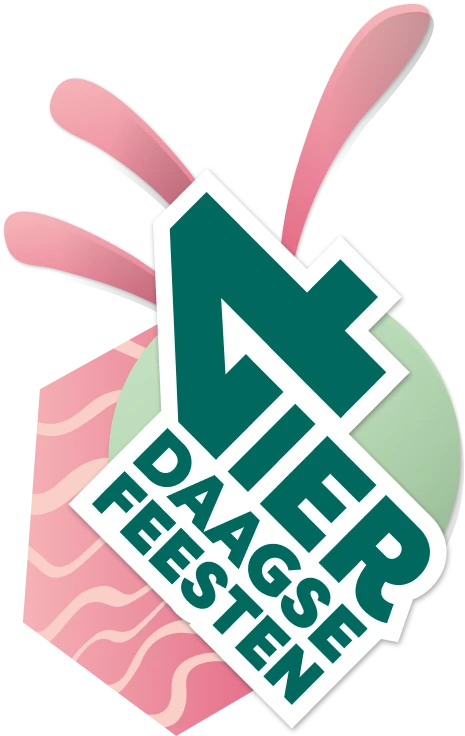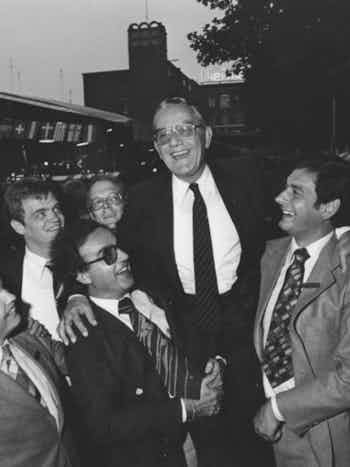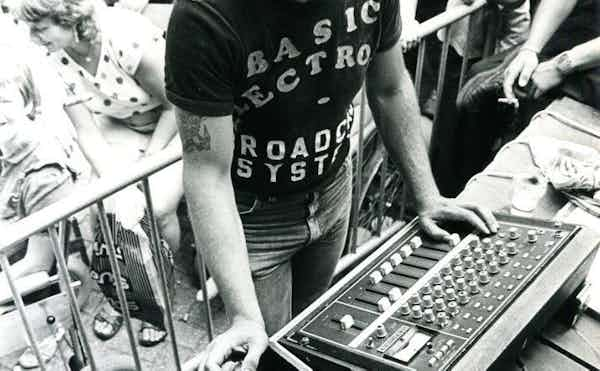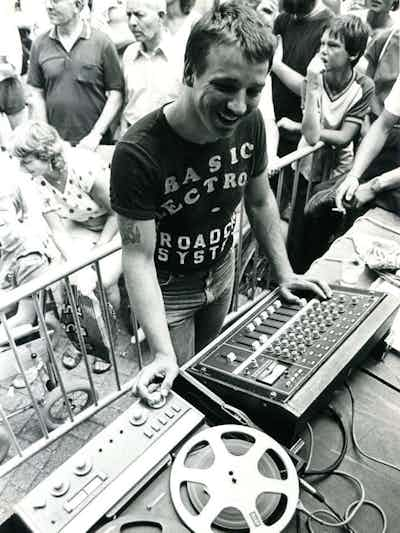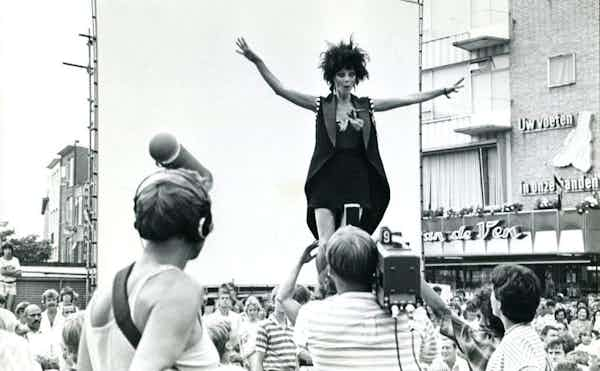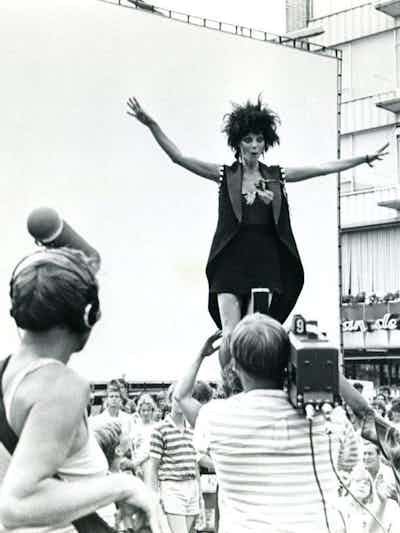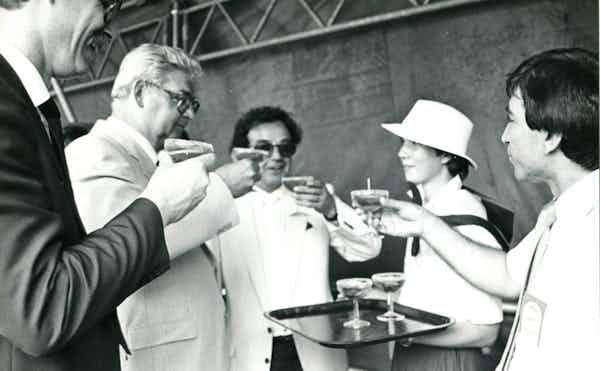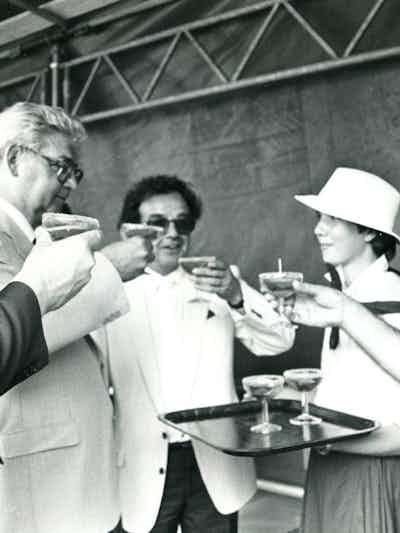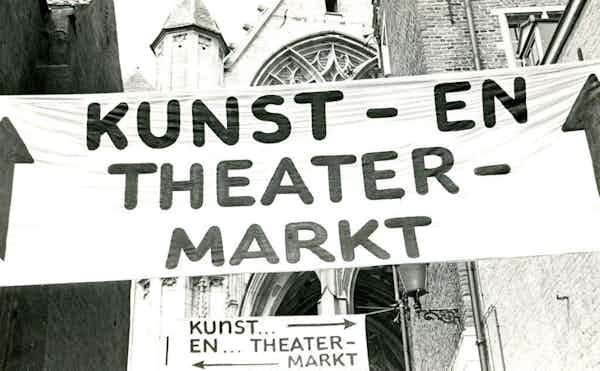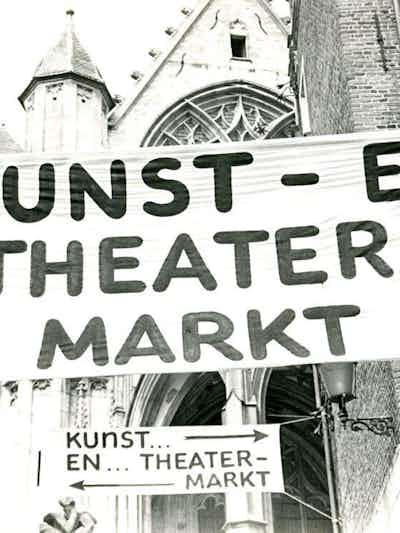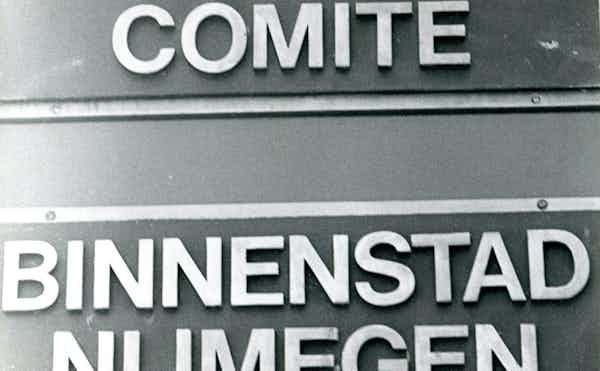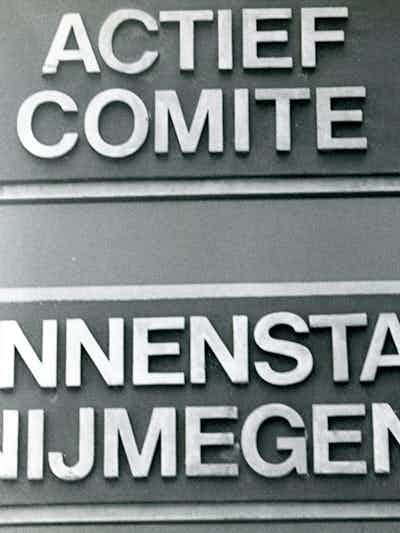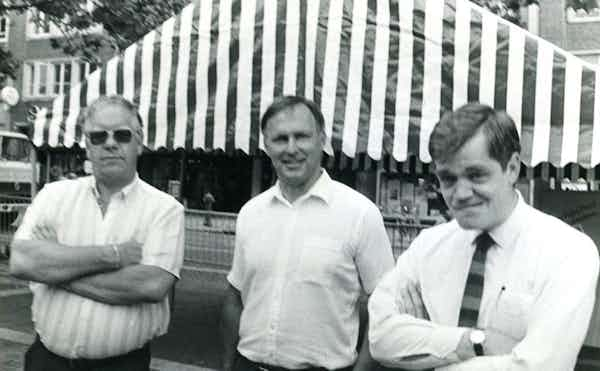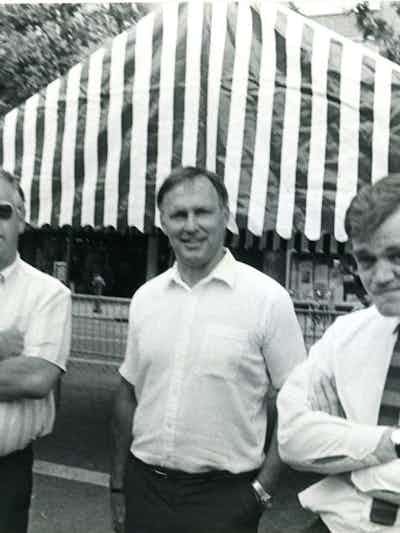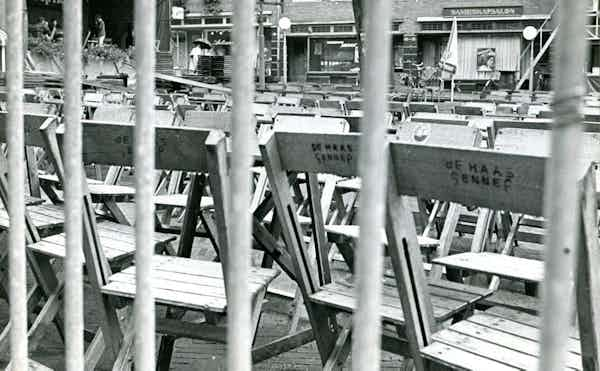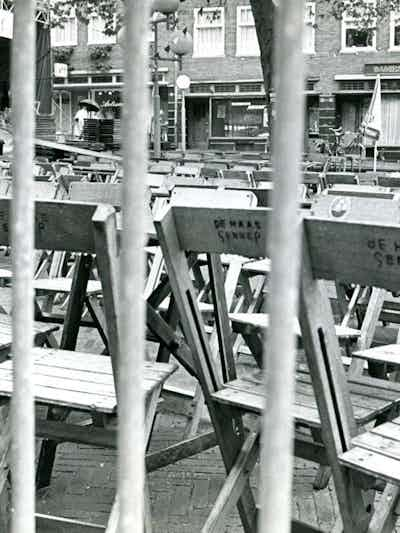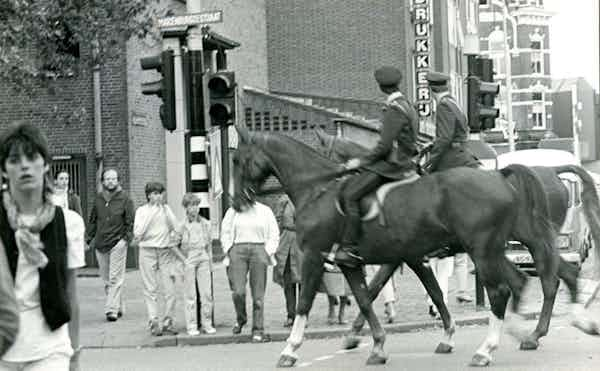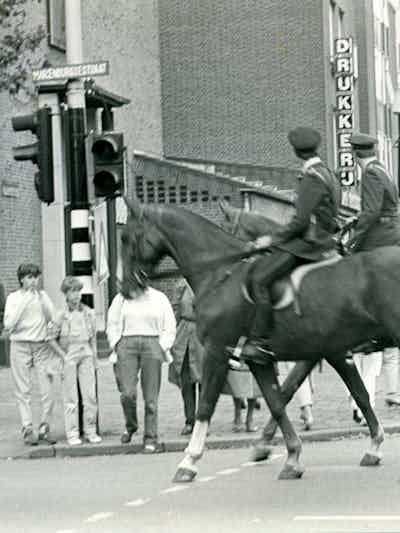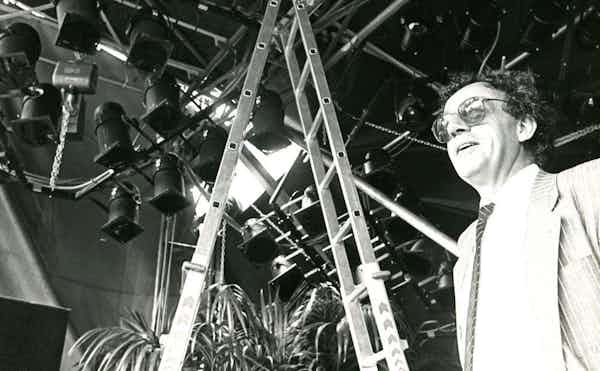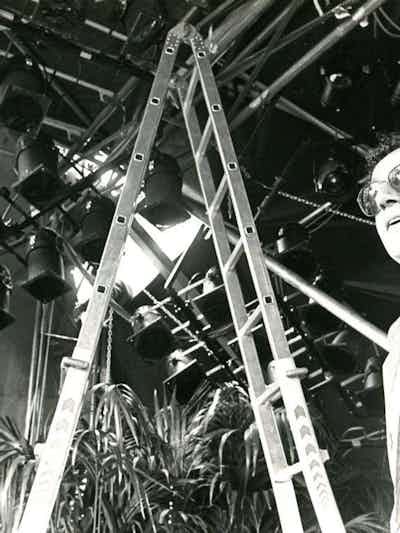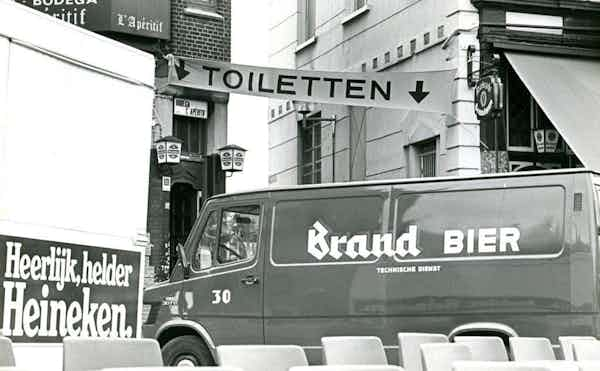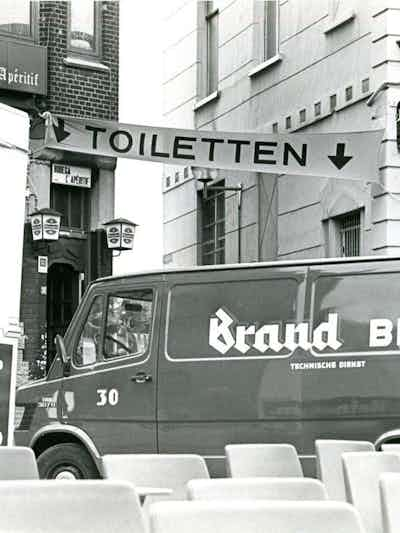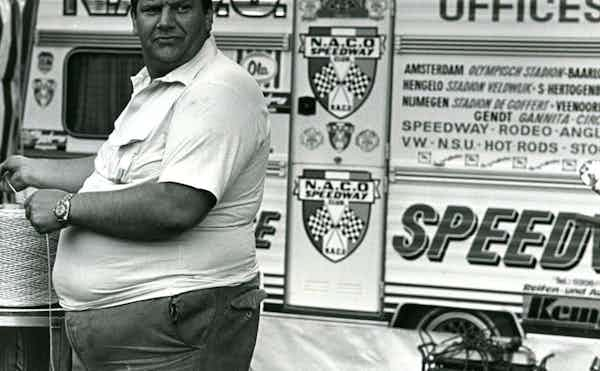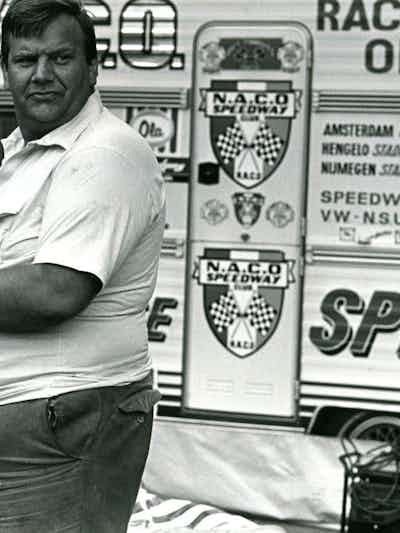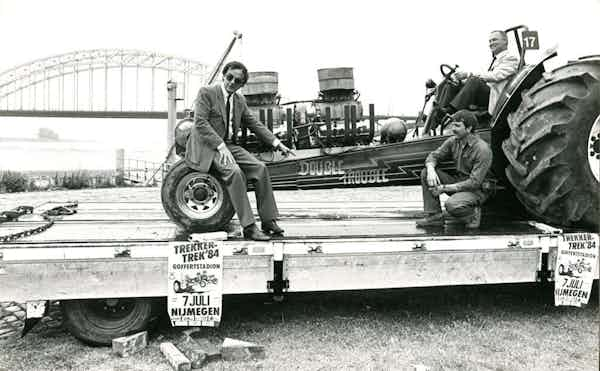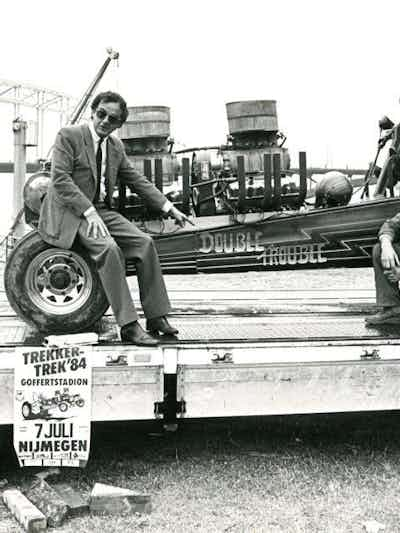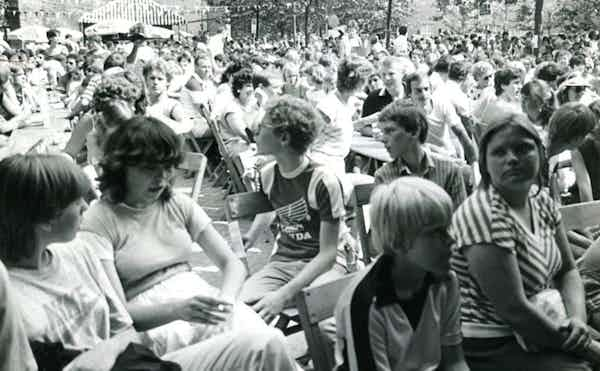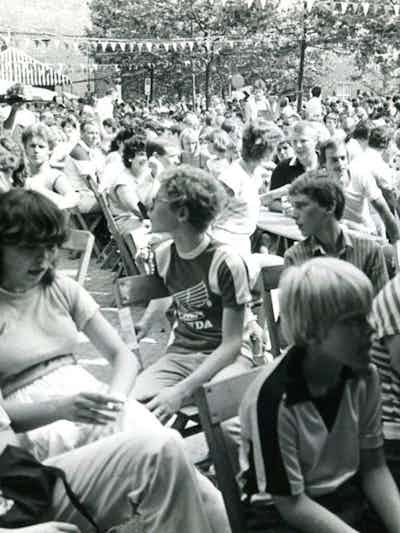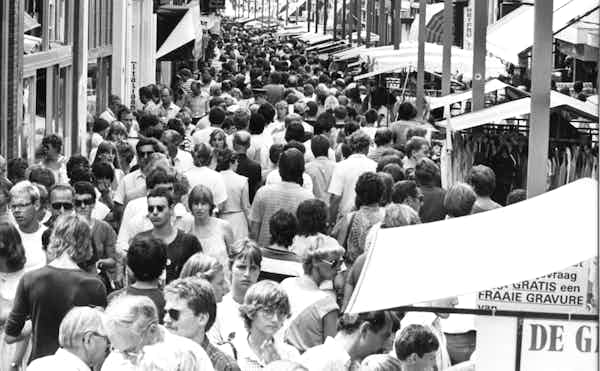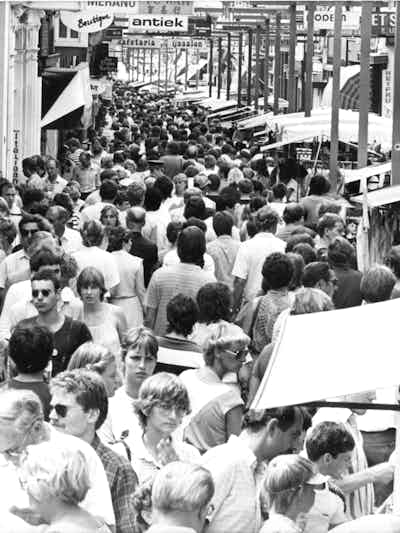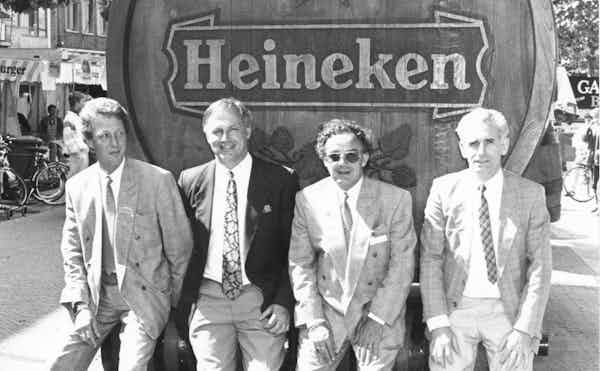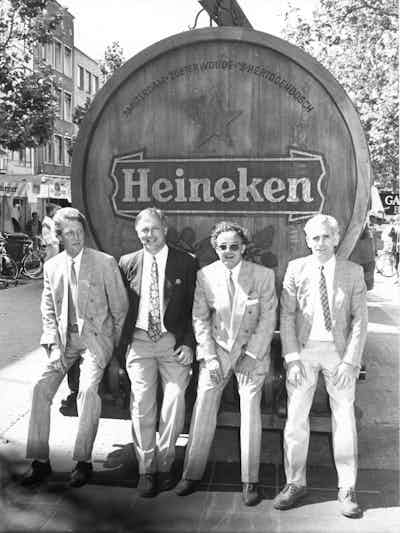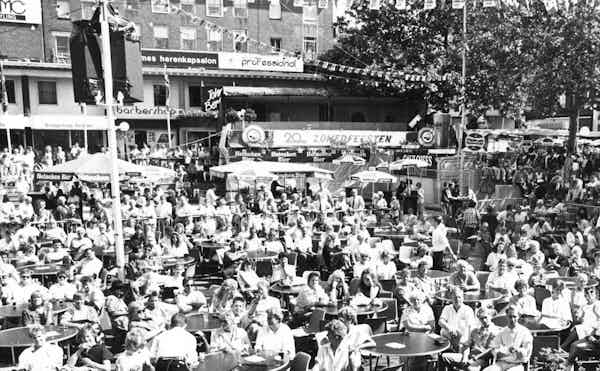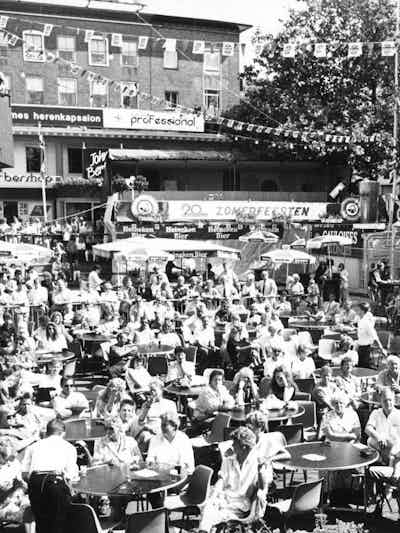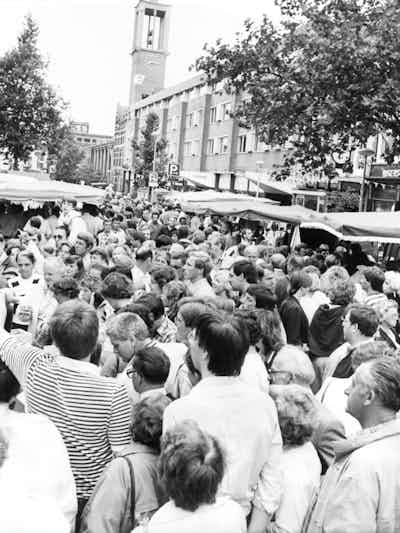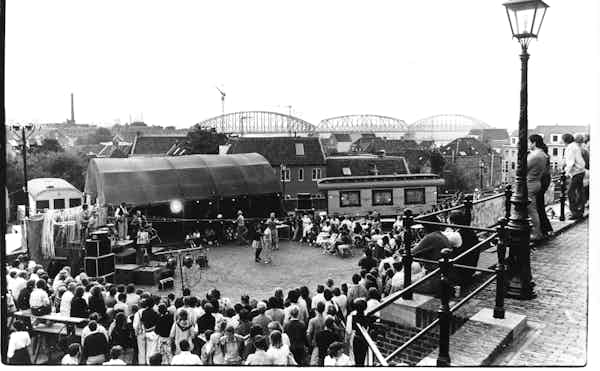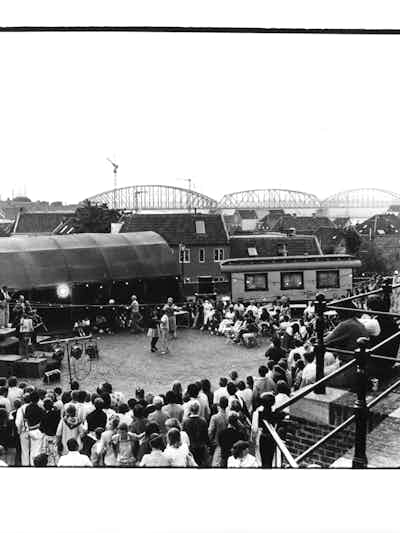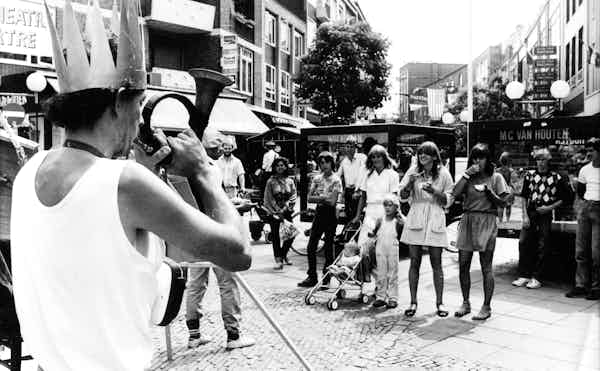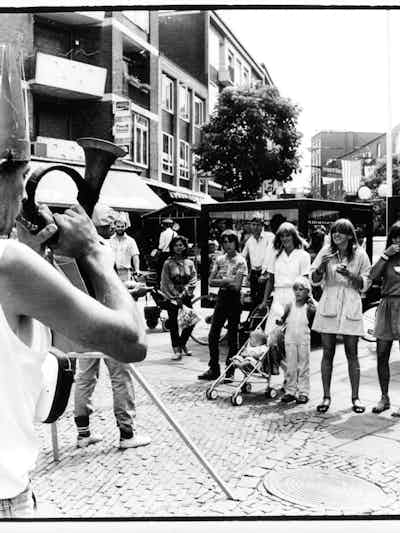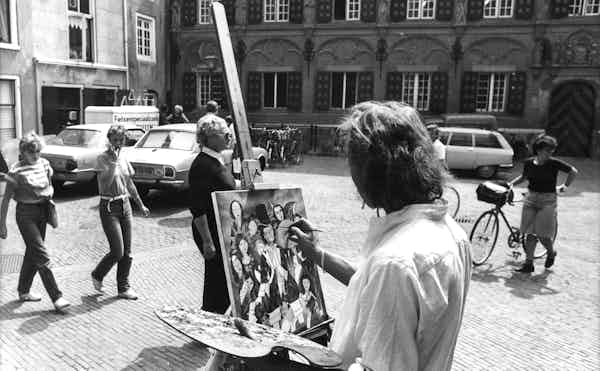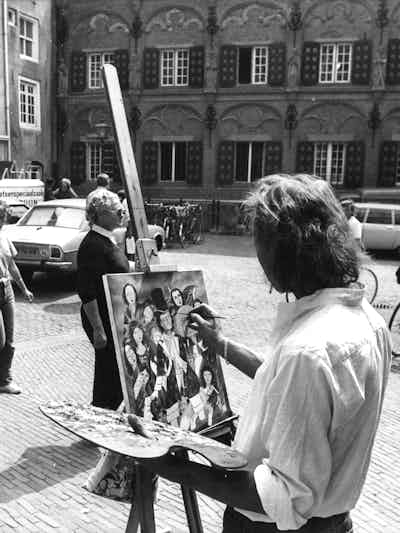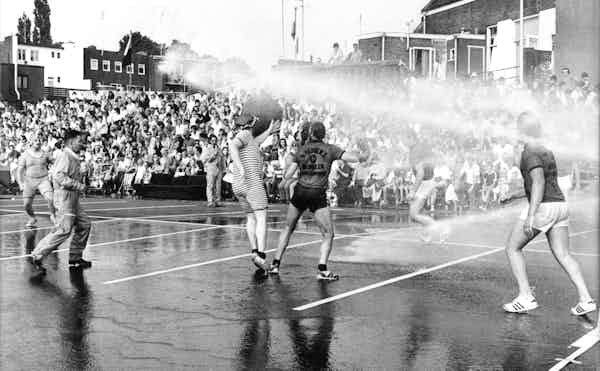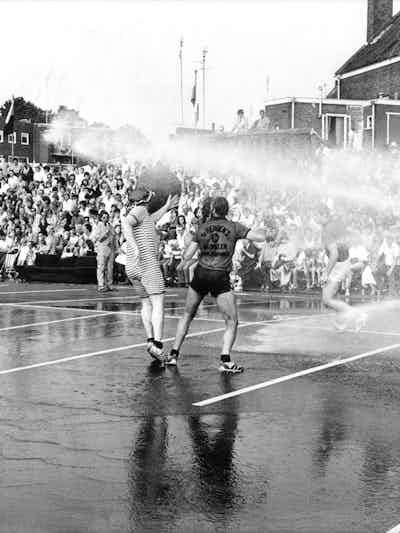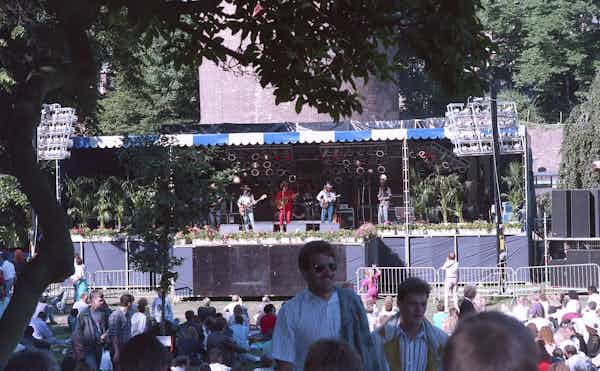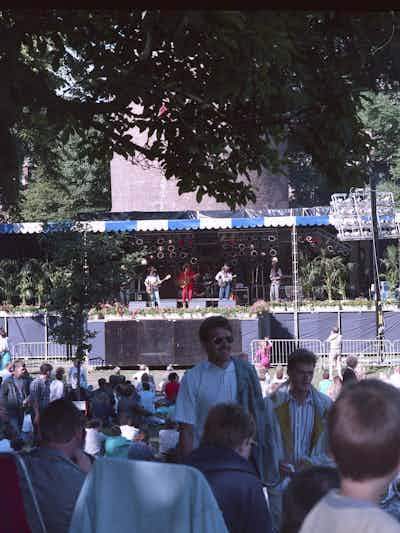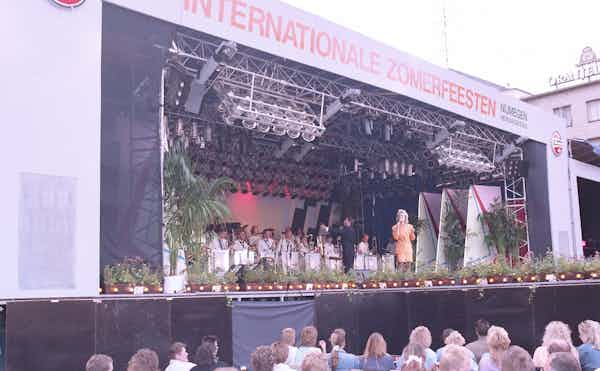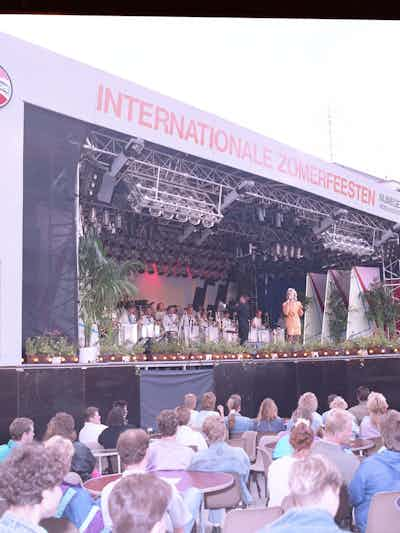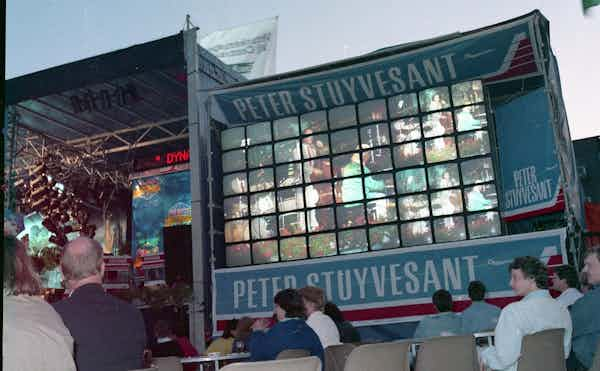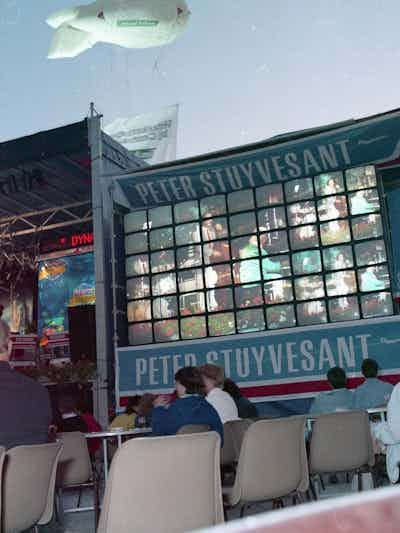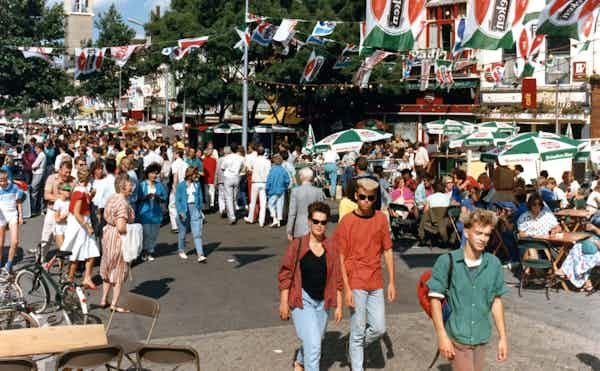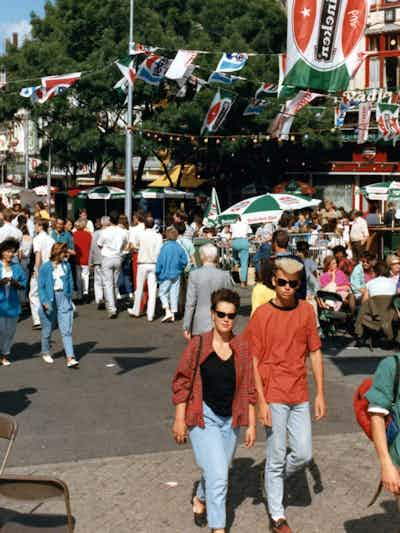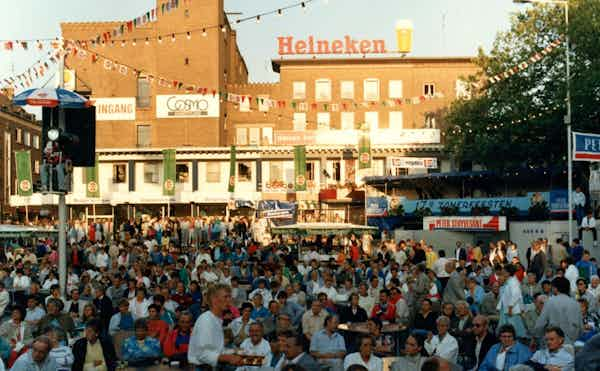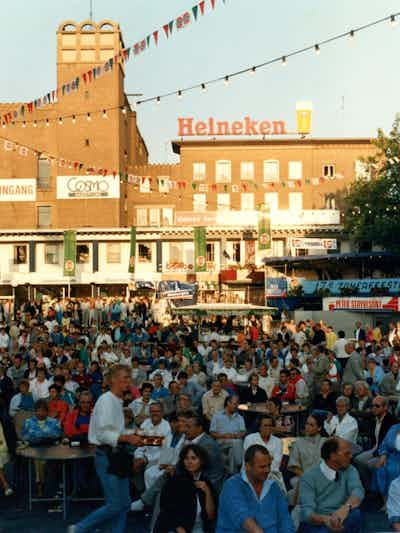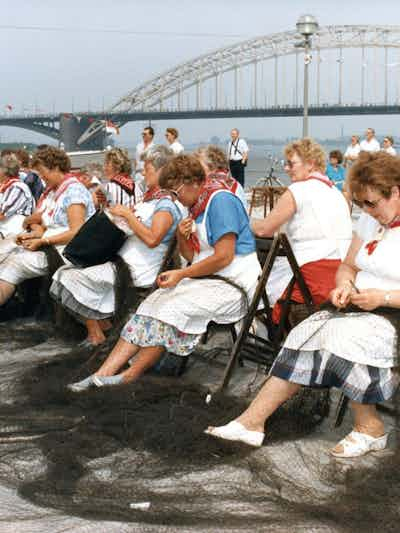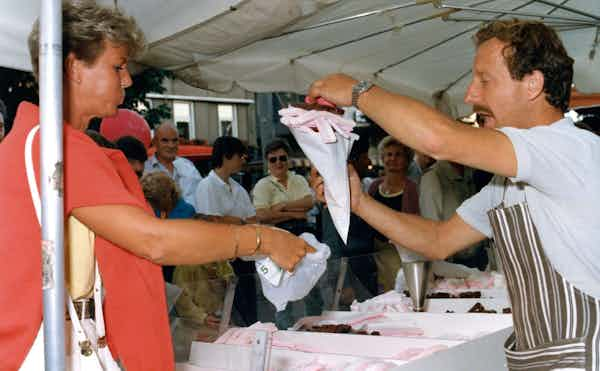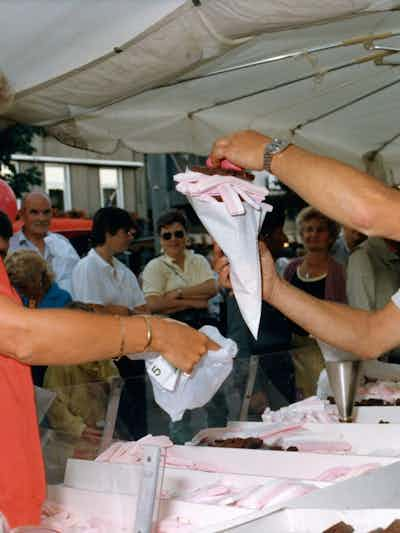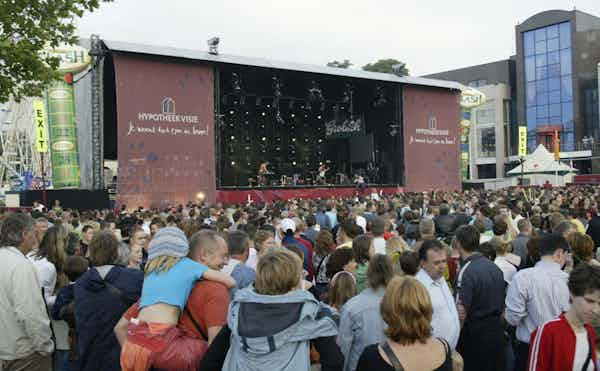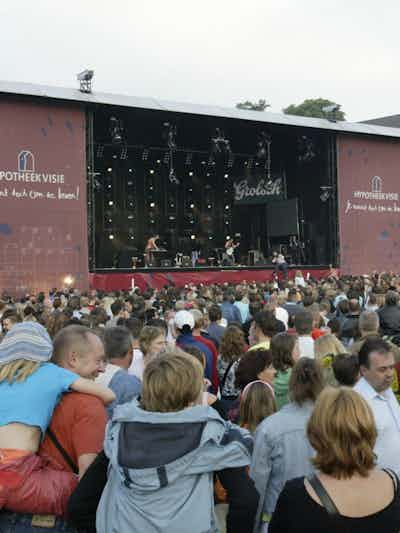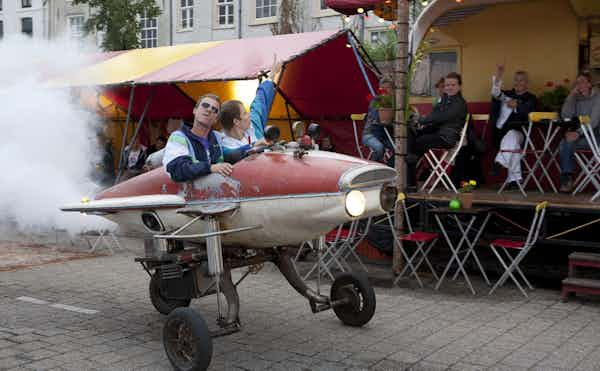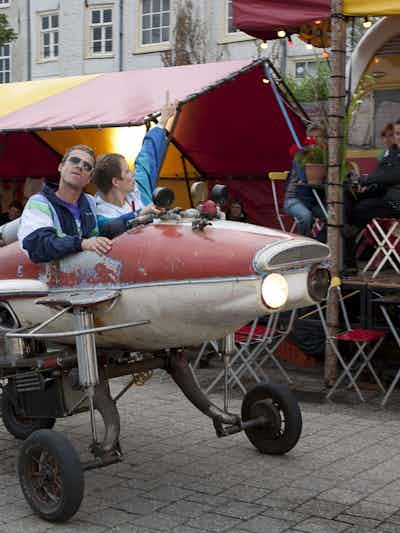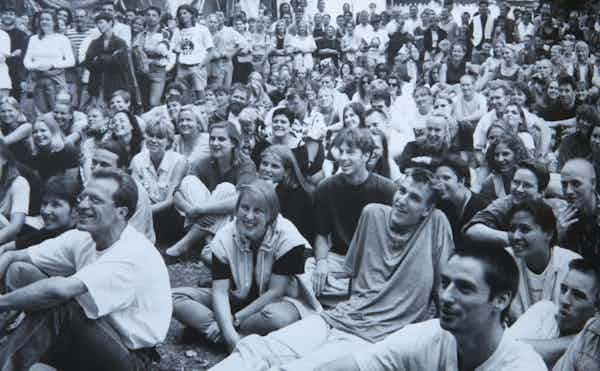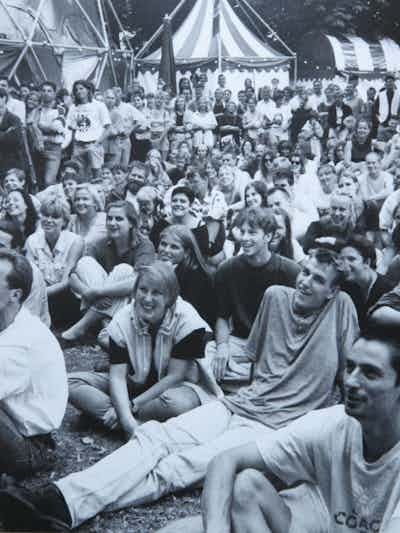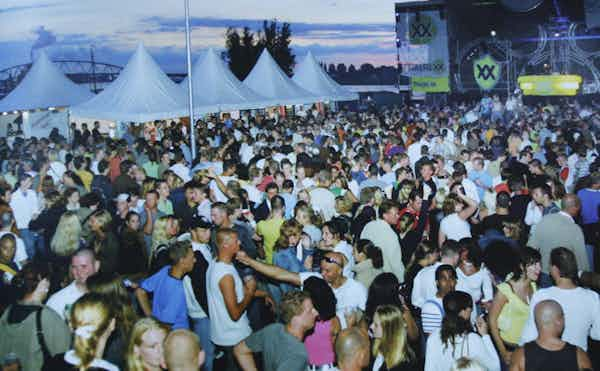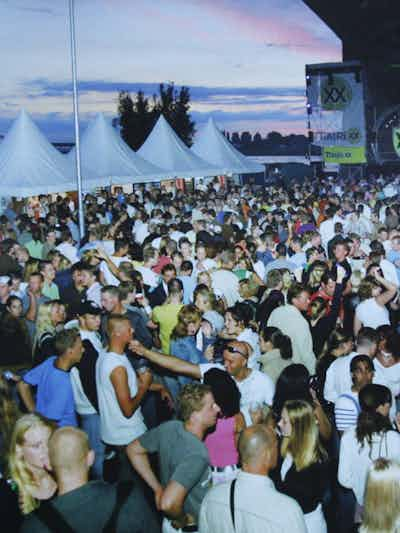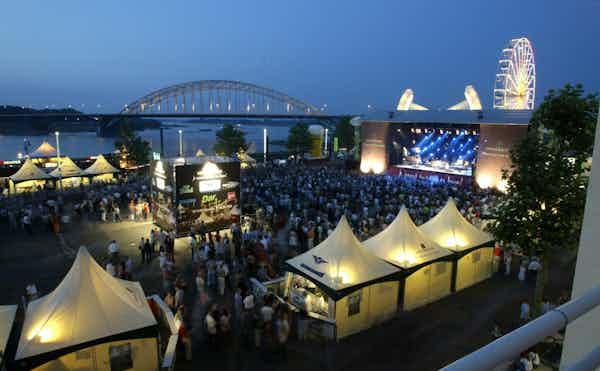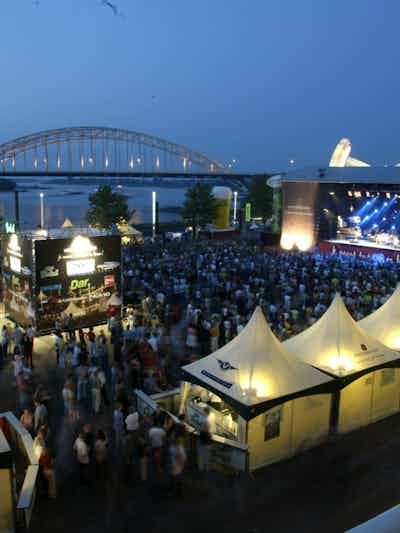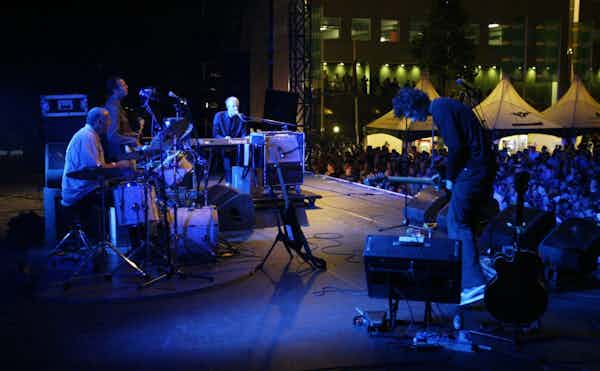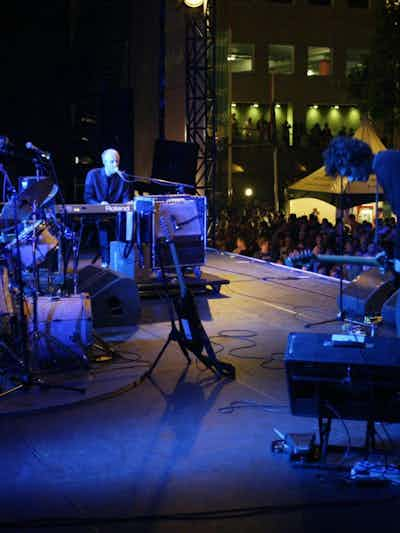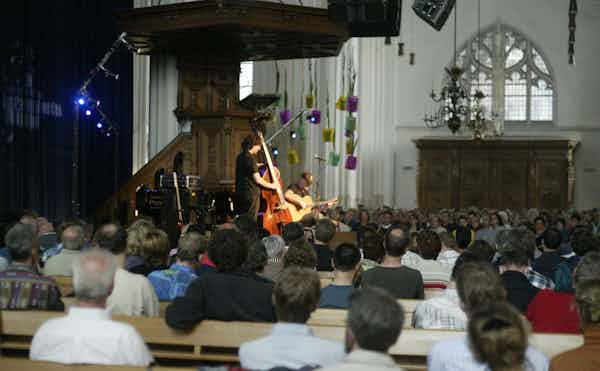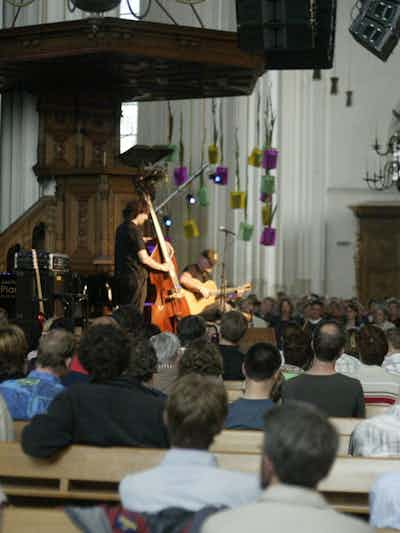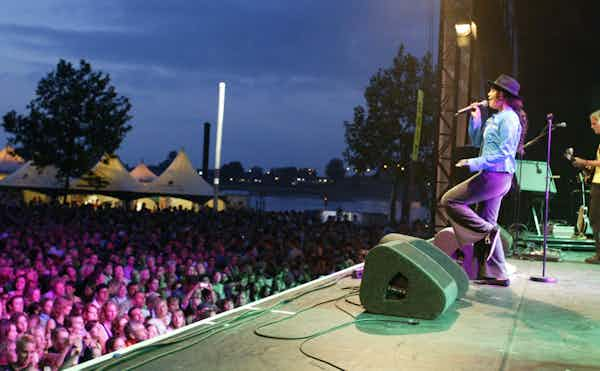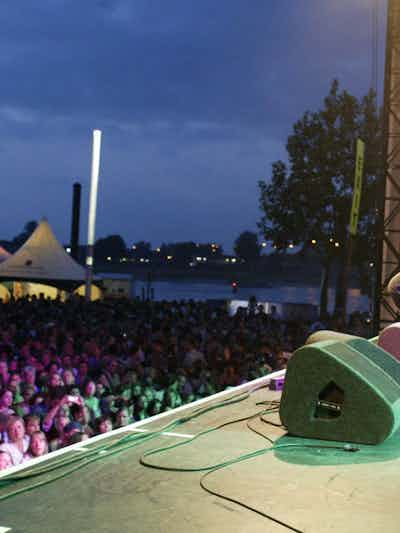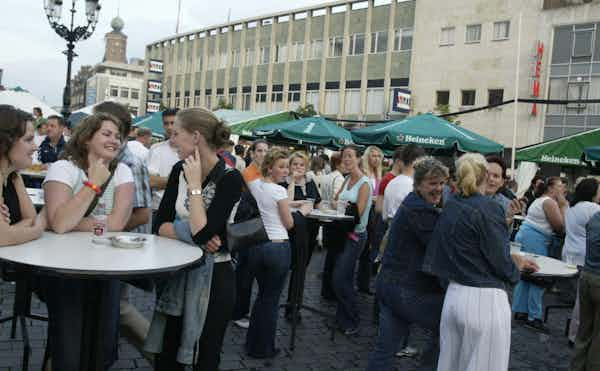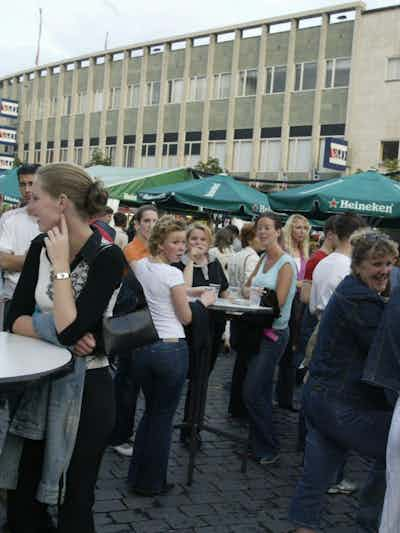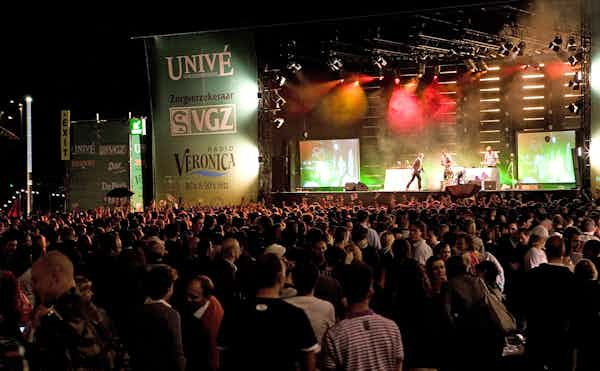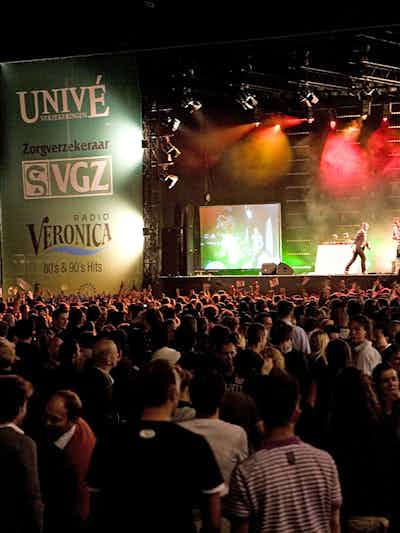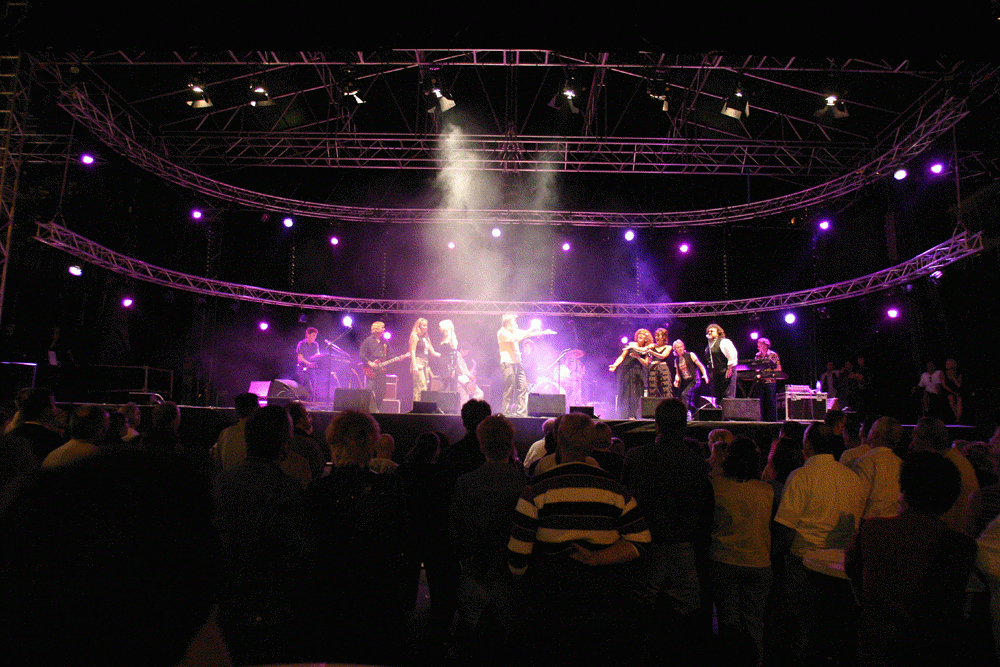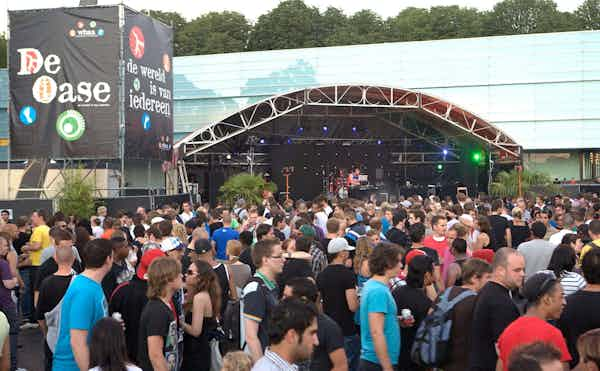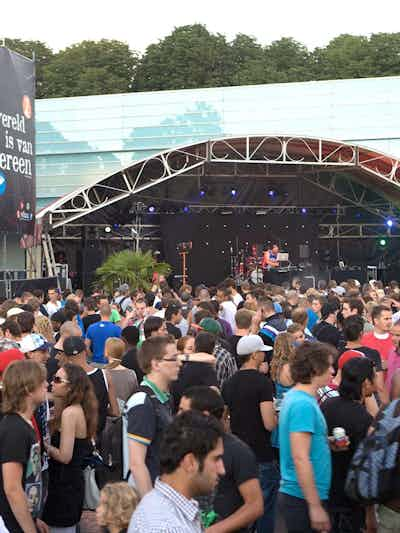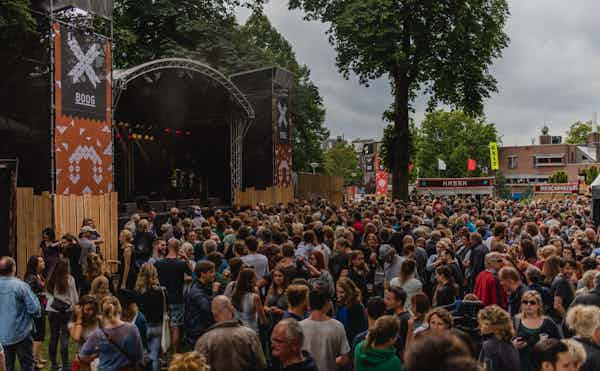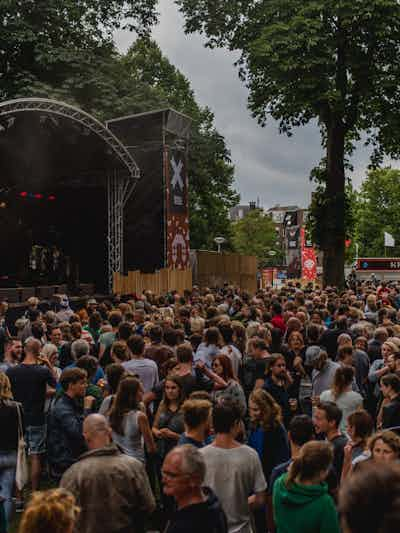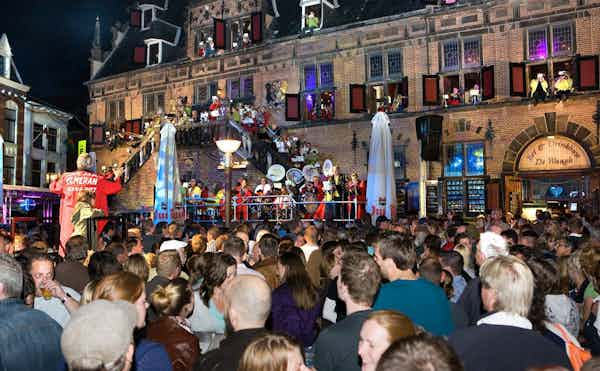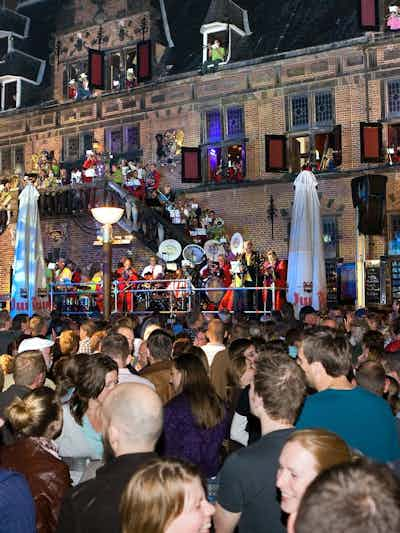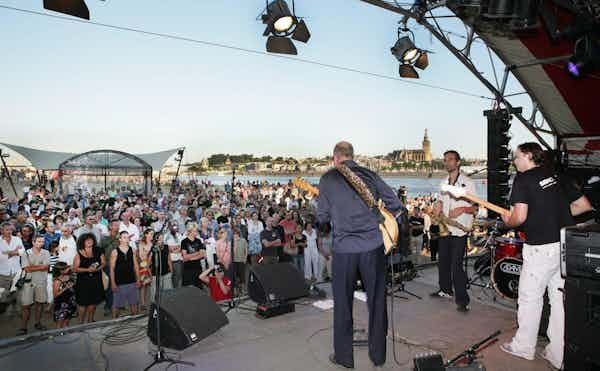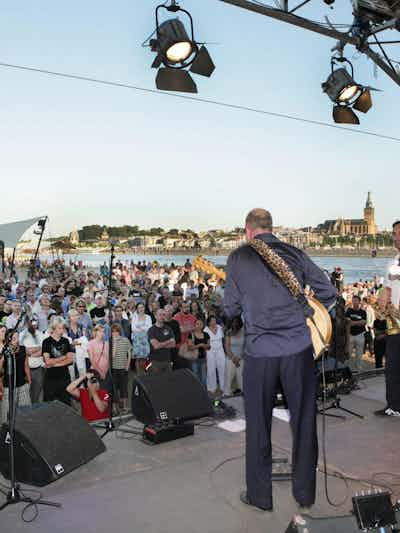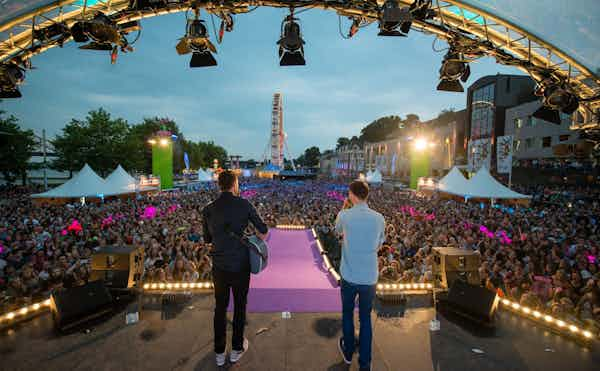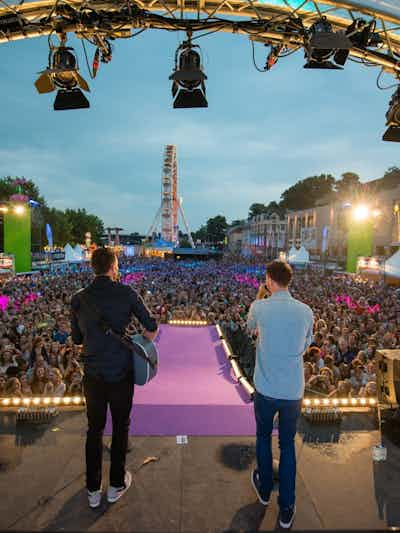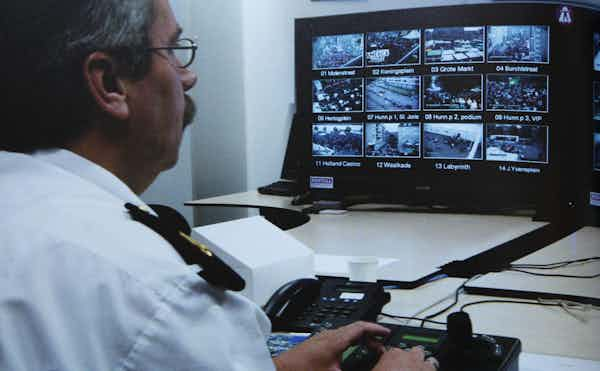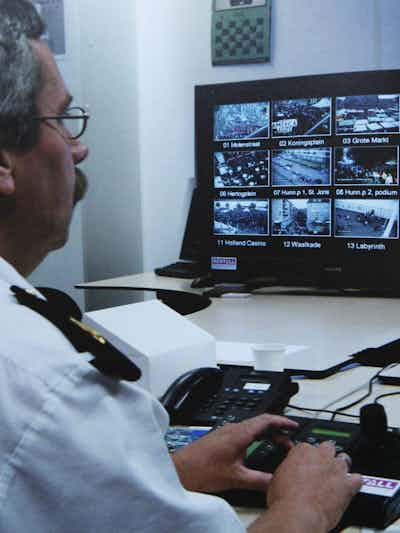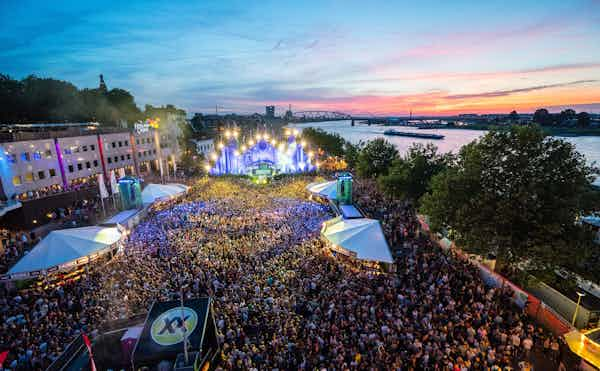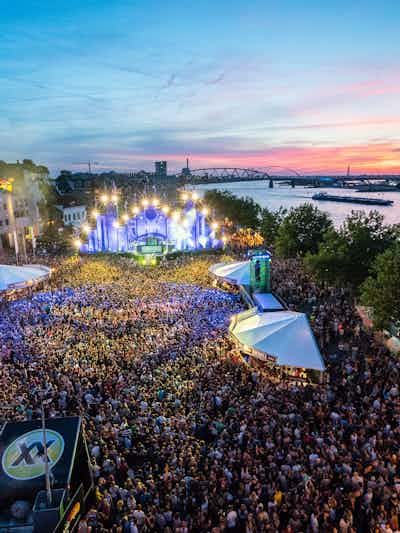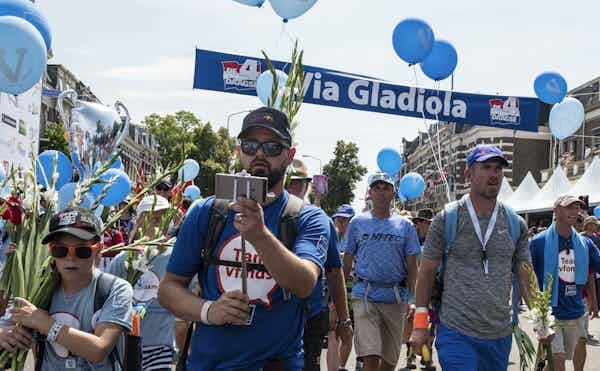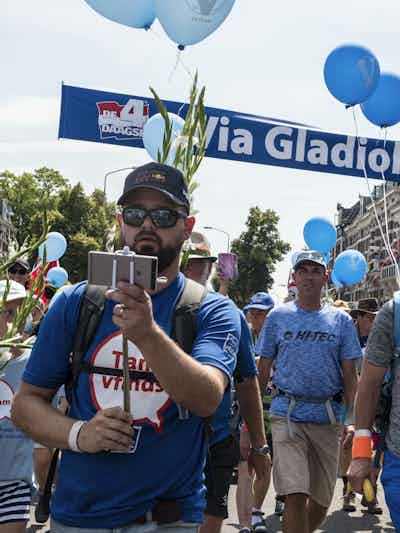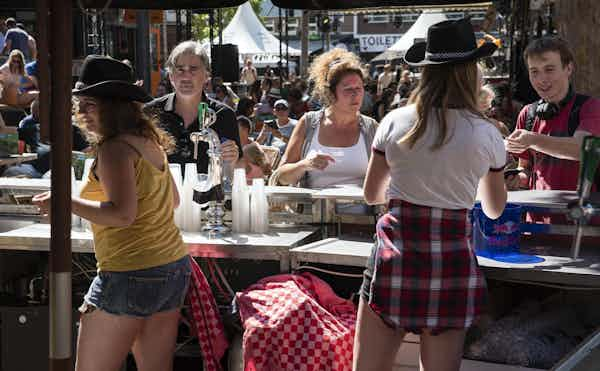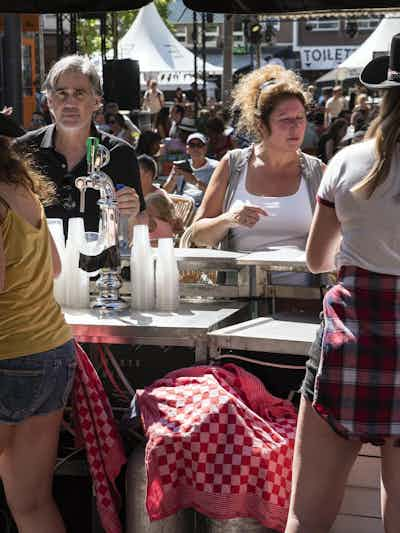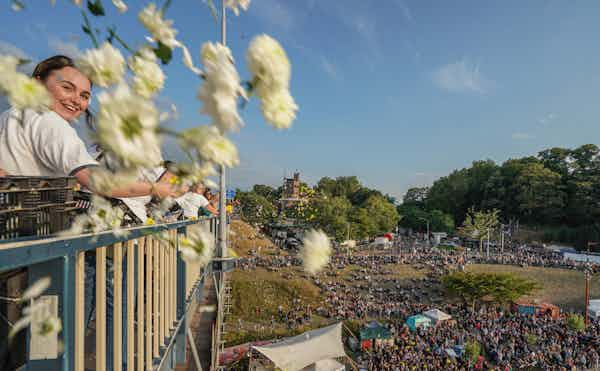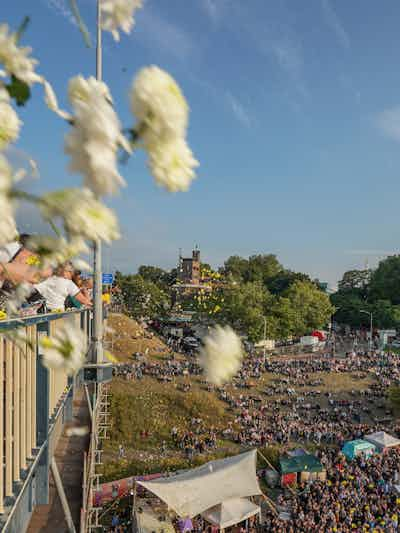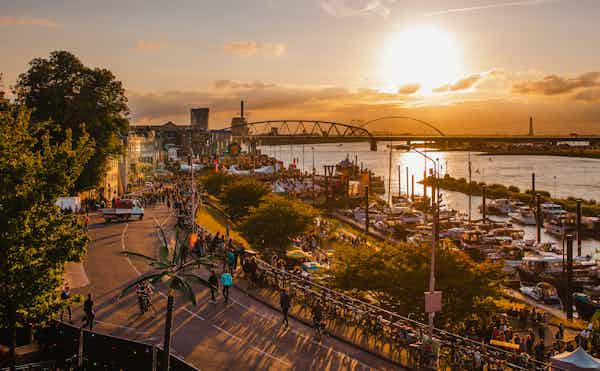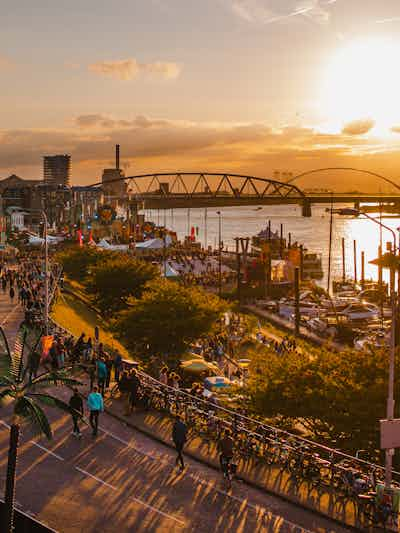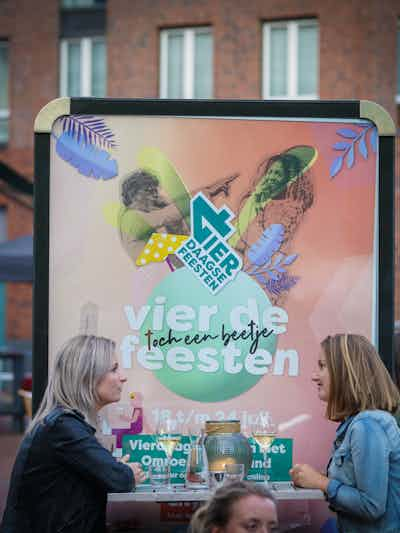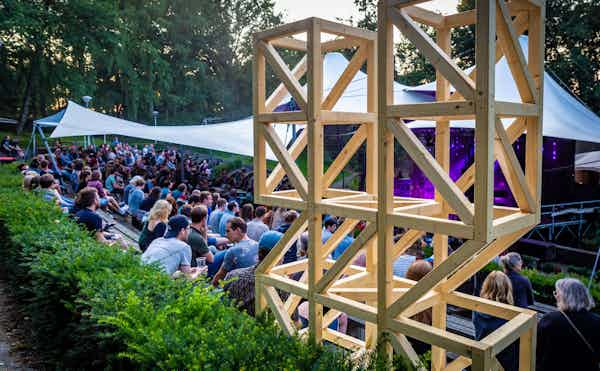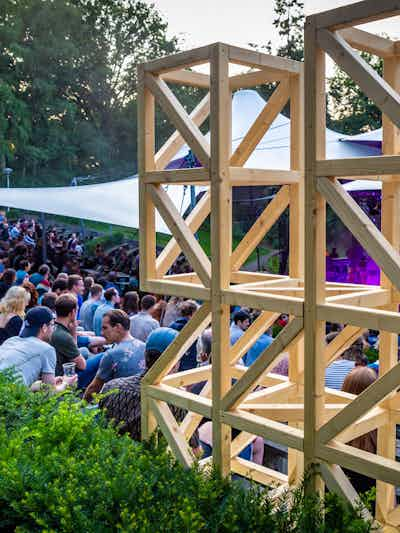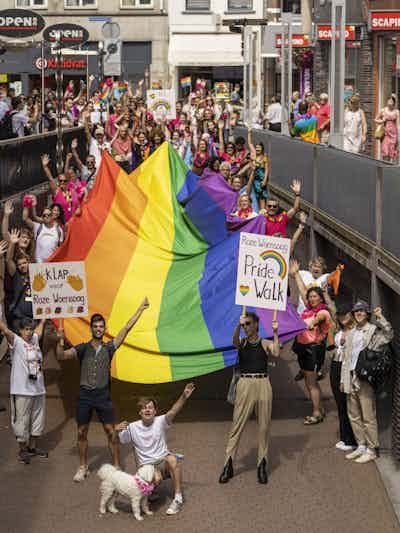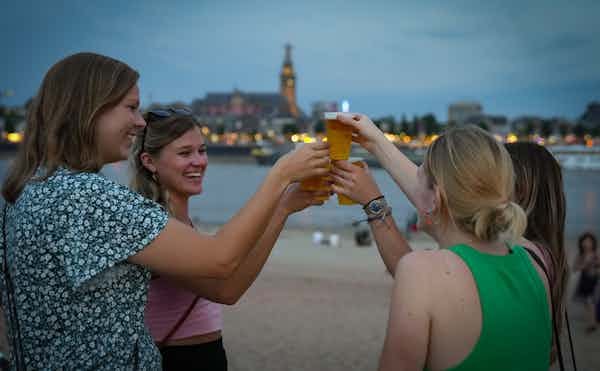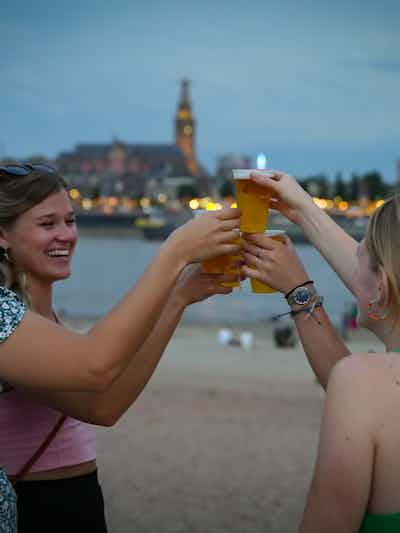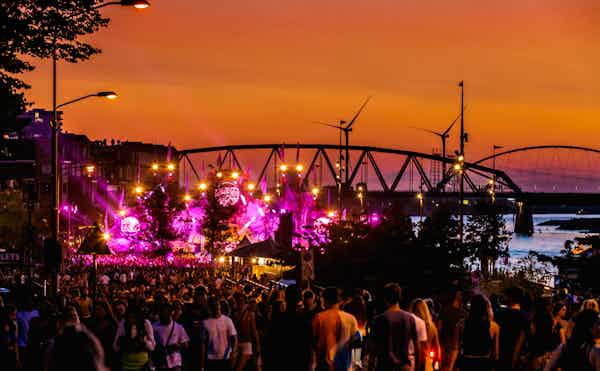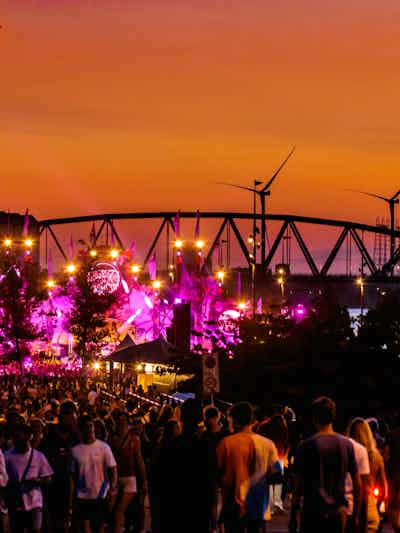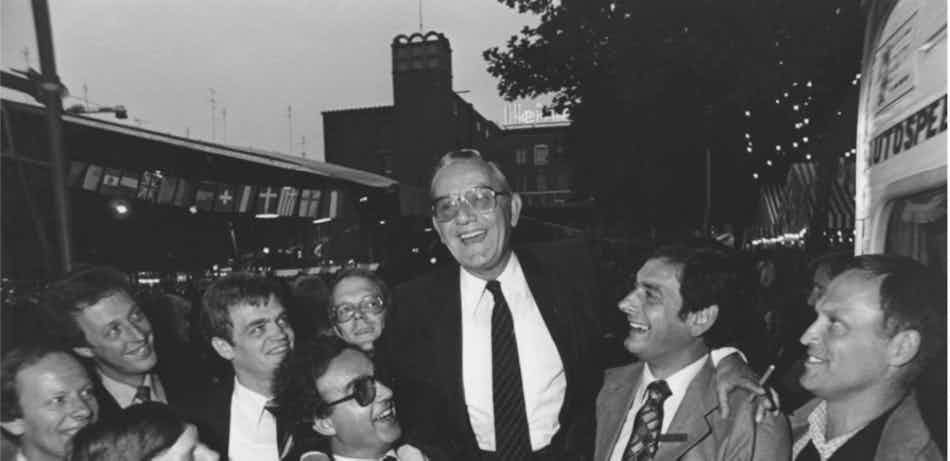



A dive into history! A look back at how it all started and what developments the Vierdaagsefeesten went through.
How it all began: concise
In 1969, the 53rd4‑day walking march was overshadowed by Neil Armstrong’s historic moon landing. The steps of the then 15,000 walkers went virtually unnoticed: walkers wanted to be inside early to watch the TV broadcast. There were also no activities in Nijmegen city centre that could change their minds.
It was the last summer without Zomerfeesten. The last summer without what is now called the Vierdaagsefeesten. It was Nico Grijpink who sounded the alarm immediately after this 4‑day event. It couldn’t go on like this. The risk would even be that the 4‑day marches would choose another city.
In April 1970, he wrote a cri de coeur to the city centre entrepreneurs: “We have to get Nijmegen out of the mire, otherwise the Four-Day Marches will die out”. A PR agency hired for this purpose came up with the idea of sticking one guilder on the invitation to all Nijmegen shopkeepers with the text “This must be the first win”. Too much for Grijpink, however, he turned it into quarters.
Things took a storm at this meeting. De feesten were born.
Translated with DeepL
How it all began: comprehensive
The 1969 Four Day Marches were completely overshadowed by the historical lunar mission Apollo II, which launched on the Wednesday of the Four Day Marches from Cape Kennedy. On 20 July 1969 Neil Armstrong became the first man to walk on the moon and spoke the well-known words ‘one small step for man, but one giant leap for mankind.’
The opposite could have been said of the 53rd edition of the Four Day Marches. The steps taken by the 15,000 walkers of the time went pretty much unnoticed. Walkers wanted to be back early to watch the TV broadcast. And there was nothing going on in the Nijmegen city centre to make it interesting for them to stay.
The days that followed were even worse. On Friday afternoon, the day of the finish, the shops closed their doors early and the Nijmegen city centre was as empty as on a Sunday afternoon. It was the last summer before the introduction of the Summer Festival. The last summer without what is now known as the Vierdaagsefeesten. It was Nico Grijpink who drew attention to this right after the 1969 Four Day Marches. Things had to change, he argued, or Nijmegen might lose the Four Day Marches, which would migrate to another city. The responses he got were very encouraging. On 15 September 1969, the first meeting of the organisation committee took place.
At the second meeting, on 26 January, the organisers already had an extensive, albeit provisional, programme for 1970. But Grijpink wanted to involve the entire Nijmegen city centre. In April 1970 he sent out a passionate appeal to the city centre business owners: ‘We must save Nijmegen, or the Four Day Marches will soon become a thing of the past.’ This led on 14 April 1970 to a historical meeting at the Centrum cinema. A PR agency hired for the purpose came up with the idea of attaching a guilder coin to the invitation sent out to all Nijmegen shop owners with the words: ‘This is your first profit’. Grijpink thought it too much of a good thing, and reduced the amount to one quarter.
The meeting drew a big crowd, and the festival was born. After that new people appeared alongside Nico Grijpink: Gerard van Groningen, John Bertine, Charles de Mori, Ger Leenders, Herman Bertels, Piet Bruins, and Frans Grootaarts. Giants on whose shoulders we stand today as we continue to help develop the festival. ‘A festival that can never again be imagined anywhere other than in Nijmegen,’ Grijpink was quoted saying in that year.
Dear people, this year we celebrate the Festival’s 50th edition. I’m delighted with this opportunity to share with you the story of how this festival was born, right now, at the start of our jubilee year. Many of you already know the story, yet it can’t be told often enough. And what resonates in it for me is the fact that Nico Grijpink saw it as an essential condition that we do it all together. Something that is as true today as it was then.
Foreword by Walter Hamers, Board President of Stichting Vierdaagsefeesten, held at the Ambassadors’ Club on 12 February 2019.
The 1970s
From its early days in 1970 the festival went through a huge growth spurt. With incredible effort a budget of 25,000 guilders was collected in 1970 to organise the first edition of what was known at the time as the ‘Summer Festival’: 5,000 guilders from the Event Committee and 20,000 guilders from 500 shop owners who each contributed 40 guilders. Restaurant and café owners, who were also invited to contribute, didn’t donate a cent. ‘To ensure some extra music the Four Day Marches marching bands had to be ‘bribed’ with 25 guilders to make an additional round of the city after the finish.’
The Four Day Marches Board was enthusiastic and some form collaboration was sought with the KNBLO (Royal Dutch League for Physical Education). The Four Day Marches route was even adjusted and since then, the walking route of the second day takes the walkers right through the centre of Nijmegen. In order to get the military walkers from Heumensoord to the city, free shuttle buses ran all week, and thousands of Nijmegen citizens took to the streets in large numbers.
A survey conducted during the festival revealed that the ‘Summer Festival’ had generated 20%-60% surplus profit. In short, the festival was a great success and deserved to be repeated.
1971 saw the introduction of the ‘De Waal in Flames’ fireworks display, which continues to be inextricably linked to the festival to this day. After some experimentation, the festival found its current format in 1973, with a Saturday opening ceremony and a Friday evening closing ceremony. Plein’44 and the Grote Markt were the main venues in those early days.
For the music programme the organisers drew on the mass of popular hit parade artists that flooded the Netherlands in those years. From Rob de Nijs to Herman Brood, and from Corrie Konings to the Dizzy Man’s Band. The concerts of the Zangeres zonder Naam (Singer without a name), who was asked to come back for six consecutive years, were especially legendary.
The 1980s
In the 1980s the Summer Festival grew into a strong, colourful spectacle that sometimes attracted as many as 800,000 party-goers. The Nijmegen Municipality was charged with issuing permits for terraces and kiosks and making sure that the rules were respected. This helped clarify what was available where, an important element in the safety of the steadily growing crowds who found their way to the festival.
In the mid-1980s, the authorities strengthened their enforcement and monitoring efforts. Where the rules were ignored, yellow and red cards were issued. These organisational changes in the 1980s went completely unnoticed by the public, who continued to enjoy all that was on offer. The festival was here to stay and the music programme was absolutely phenomenal.
In 1985 the Valkhof was added to the list of festival venues. The park, with its alternative programme, was intended as a resting point in the bustle and revelry of the city centre. It was an overnight success. The alternative programme and unique atmosphere added a special element to the festivities.
In the meantime, the growing visitor numbers were a cause for concern. When would the festival reach full capacity, and how could public order and safety be safeguarded? In 1989, on the festival’s 20th edition, with a budget that for the first time exceeded 1 million guilders, the festival organisers nevertheless expressed the hope that the Festival would continue to attract as many visitors as possible.
The 1990s
In 1992, the Nijmegen Municipality conducted a large-scale survey among the festival audience. A short summary: a total of 800,000 visitors came to Nijmegen to attend the festival. At least 80,000 of the 125,000 Nijmegen citizens aged 15 and older visited the festival one or more times, 22% of the visitors came from within the region, 32% from other parts of the Netherlands, and 6% from abroad (mostly the German border area).
The survey also helped refute the frequently heard complaint that the Four Day Marches walkers were unable to take part in the festival. Approximately 60%-70% of the walkers did attend the festivities, usually on Sunday, Monday and Friday. The profits exceeded 20 million guilders. 85% of the visitors said they attended the festivities because of the great atmosphere in the city. The festival was given an average rating of 7.8.
By the mid-1990s the Vierdaagsefeesten had grown into a massive, enthralling and most importantly free music festival spread across the entire city. The Gevelconcert, which moved from its original location in the Molenstraat to the Grote Markt, featured appearances by ‘dweilorkesten’ (traditional Dutch Carnival orchestras) and grew into a huge hit.
In 1993, the ‘Kunst in de Kerk’ (Art in the Church) project was launched in the St. Stevenskerk, with the intention of creating an oasis of calm in the midst of the busy festival. Young Dutch artists were invited to exhibit their work and one famous artist was asked to create an artwork inspired by Nijmegen: the Nijmegen engraving.
In 1998 the name ‘Zomerfeesten’ (Summer Festival) was changed to Vierdaagsefeesten to strengthen and clarify the link with the Vierdaagse (Four Day Marches).
The 21st century
Conviviality, crowds and professionalism were the keywords of the Vierdaagsefeesten in the Noughties. Whereas at first the Vierdaagsefeesten had been primarily supported and organised by Nijmegen business owners, by 2000, the festival had grown too big for them. In particular the safety measures and required ‘refurbishing of the city’ meant the festival had become increasingly more expensive. A shift towards ‘the outside’ was needed to attract sponsors and other financers.
In the second large-scale public survey, held during the2001 Vierdaagsefeesten, visitors gave the festival the same ranking as in 1992: 7.8. Most respondents listed the atmosphere as their most important reason for attending the festival, and 75% of visitors were happy with the music programme. ‘The Waal in Flames’ and the Gevelconcert continued to attract large crowds and the visitors represented all age groups. 42% of visitors came from ‘elsewhere in the Netherlands’, 38% from Nijmegen and surroundings, 15% from the wider region, and 5% from abroad.
In 2001, the Vierdaagsefeesten attracted 1 million visitors, making it for the fifth consecutive year the best attended event in the Netherlands. The festival offered more than 100 performances by artists such as Venice, Volumia, Twarres, Jody Bernal, Milk Inc and Di-rect. More than 250 cafés and restaurants jointly put out 20,000 terrace chairs.
In 2003, Frank Boeijen performed at the opening night in the St. Stevenskerk and gave an additional concert later that night on the Waalkade. DJ Tiesto was to be the greatest attraction of the Vierdaagsefeesten on the Matrixx podium under the Waalbrug, but the Nijmegen Municipality unfortunately had to cancelled his performance for safety reasons.
2005 was a successful year with 150 terraces and 30 music podiums in the Nijmegen city centre. The festival’s success was also apparent from the fact that a large number of visitors came to the exhibition in the church and more than 60,000 visitors enjoyed the fireworks and music display on the Waalkade.
In 2006 the Four Day Marches had to be cancelled due to a heat wave, which resulted in a very special year for the festival. All podiums in the city observed a one-minute silence, as a prelude to a more subdued and respectful festival edition.
While the2007 Vierdaagsefeesten organisers ran around dealing with toilet problems, stands that had to be adequately fire-proofed, squares that were nearly reaching full capacity, programme changes, the weather, and many other things, the visiting crowds focused on enjoying themselves. On Friday, the Waalkade was turned into a one-way traffic system for the first-time – which greatly helped reduce congestion on the quay.
The 2008 Vierdaagsefeesten ranked first in the Top 100 Event Monitor. Big festival artists made an appearance, including Room Eleven, Nick & Simon, Stevie Ann, Claw Boys Claw, Moke, Alain Clarke, Memphis Maniacs, Voicst, Bosshoss, CCC Inc, Leaf, Van Velzen, Beef, Mark Foggo, Don Diablo and Gabriel Rios. The week was concluded with a roaring concert by rock band Normaal.
The good weather, the great diversity of music and theatre performances, the quality improvements on the preceding years and the increasing diversity among visitors all conspired to make 2010 a top year. More than 1.4 million visitors saw more than 2100 artists perform on the 30 festival podiums, while 325 additional trains were put on to transport the visitors.
The 2010s
Stichting Vierdaagsefeesten shifted its role from organiser to director. Instead of volunteers, the festival was now in the hands of professionals, and instead of acting from a position of authority, the organisation focused on collaboration and broadly supported decisions. Steering groups were created, consisting of citizens, visitors and business owners, allowing us to gather external input. Behind the scenes, we worked on further promoting sustainability and innovation.
According to visitors, the top 5 activities of the 2011 Vierdaagsefeesten were: the Waalkade, Matrixx, the Waal in Flames, the St. Stevenskerk, and the opening procession. To spread the crowds throughout the city centre the festival programme was broad and popular artists were spread over the 28 different podiums. It was a great success in crowd management.
Innovations that were introduced in 2012 included PET glasses, the Vierdaagsefeesten loyalty pass, theatre on the Waalkade, the ‘Keep the festival free; buy your beer at the bar’ campaign, the creation of permanent water taps, and a more extensive children’s programme.
Profits in the city centre increased by €6 million in 2013, up to a total of €38 million. When asked what they enjoyed most about the Vierdaagsefeesten, visitors most frequently answered ‘the atmosphere’ (69%). 15% of respondents listed other aspects, including ‘the diverse activities’, ‘the fact that it lasts a week and is free of charge’, ‘the people’, ‘the music’ and the ‘Vierdaagsefeesten reunion feeling.’
2014 was an exceptional year: with the FIFA World Cup in the leading role, combined with tropical temperatures, and on Thursday evening the crash of the MH17. The one-minute silence on Friday was impressively respectful, as was whole crowds singing along to ‘You’ll Never Walk Alone’. It was a week in which we came to understand that the festival was not only about having fun, but also about being together and sharing our experiences and emotions.
In 2015 the Vierdaagsefeesten were rated 8.6. 32% of the visitors came from the wider region and 44% from Nijmegen. 25% came from the rest of the Netherlands and abroad. This meant many people postponed going on holiday until after the Vierdaagsefeesten. The 3% of visitors who came from abroad still represented an impressive 45,000 people.
The survey also showed that 62% of visitors came back to Nijmegen for a return visit. This meant that throughout the year, 870,000 people returned for another visit because they were inspired during the Vierdaagsefeesten. 24% of festival visitors stayed with family, friends, in a hotel or on a camping site during the Vierdaagsefeesten. Clearly, Nijmegen was found to be a very hospitable city!
2016 marked the 100th edition of the Nijmegen Four Day Marches. This meant an even bigger party and more activities in Nijmegen, baptised for the occasion ‘the Summer Capital of Holland’. 1,508,500 visitors came to the Nijmegen city centre. Spread over an area of 22,000 m2, 4500 artists gave more than 1040 performances. The brand-new city island on the other side of the Waal was used for the first time by theatre festival Op ’t Eiland.
In 2017 it became apparent that the city could handle many more visitors still. In part thanks to the extended daytime programme, the Vierdaagsefeesten attracted a record number of 1,525,000 visitors. The bustle did not affect the atmosphere: the Vierdaagsefeesten were still rated 8.5 on average, with 58% of visitors really enjoying the atmosphere, and 40% being satisfied. 96% of visitors indicated that they often or always felt safe while attending the events.
Visitor numbers continued to grow in 2018. For the first time in the festival’s 49 years, the magical threshold of 1.6 million visitors was crossed. The average age of visitors was 29. Fewer and fewer people came to the city by car: 37% came by bike and 25% by train. A trend fully in line with Nijmegen’s green and sustainable ambitions, and its 2018 title of ‘European Green Capital’.
In 2019 the Vierdaagsefeesten celebrated their 50th anniversary. Among the 1,625,000 visitors, the most popular venues were Matrixx at the Park and Matrixx Live on the Quay, with performances by famous artists. Thanks to the distribution of 25% additional bin bags and an awareness campaign, the streets remained surprisingly clean. With ideal temperatures between 20oC and 24oC Nijmegen business owners could count on making a serious profit: an important pre-condition for keeping the Vierdaagsefeesten free of charge.
In 2016, the Nijmegen Four Days Marches will take place for the 100th time. That means extra lots of celebrations and activities in Nijmegen, renamed ‘Summer Capital of Holland’ for the occasion. 1,508,500 revellers will visit Nijmegen city centre. Spread over 22,000 m², there will be 1,040 performances by more than 4,500 artists. The brand new city island on the other side of the river Waal will be occupied for the first time by theatre festival Op ‘t Eiland.
That the city can easily handle even more visitors is proven in 2017. Partly due to expansion of the daytime programme, the Vierdaagsefeesten attract a record 1,525,000 visitors. The crowds are not at the expense of the atmosphere: on average, visitors rate the Vierdaagsefeesten with an 8.5, with 58% saying they were very satisfied with the atmosphere and 40% satisfied. 96% of partygoers say they often to always feel safe at the events.
Rising visitor numbers continued in 2018. Never before in the 49-year history of the event has the magic limit of 1.6 million visitors been crossed. The average age of revellers is 29. Fewer and fewer visitors come to the city by car: 37% come by bike, 25% come by train. A trend that fits in with the efforts to make the city more sustainable and greener, which may call itself ‘European Green Capital’ in 2018.
In 2019, the Vierdaagsefeesten will celebrate its 50th edition. Among the 1,625,000 visitors, Matrixx at the Park and Matrixx Live aan de Kade, with big names on the bill, are the most popular venues. The placement of 25 per cent extra rubbish bags and an awareness campaign kept the streets remarkably cleaner. With ideal temperatures between 20 and 24 degrees, Nijmegen entrepreneurs turned in a very positive turnover this year; a necessity for the Vierdaagsefeesten to remain freely accessible.
The 2020s
After an uninterrupted 50-year stint, the 2020 Vierdaagsefeesten were cancelled because of the coronavirus. But Nijmegen was by no means deserted: while respecting the 1.5 metre distancing measures, the terraces still managed to be full all week. There were also many surprising initiatives, from small-scale performances at indoor locations to creative treasure hunts through the city. For those who remained at home, a seven-part programme was broadcast, entitled Vierdaagsefeesten with Omroep Gelderland.
Also in 2021, the Vierdaagsefeesten could not take place due to the corona pandemic. Yet the festivities did not go unnoticed: the city was festively decorated, you could have your picture taken as a Vierdaagsefeesten artist at various photo boards, drink a first official Vierdaagsefeesten beer on the terrace or go to the private programmes of Valkhof Festival, Doornroosje and Otis Park, among others.
In2022, we moved on again: the 51st edition of the Vierdaagsefeesten took place. After two absent editions, the Vierdaagsefeesten were officially opened for the first time, on 17 stages simultaneously, by Nijmegen comedian Pieter Derks. As the first city-wide event, we set up a return system for high-quality recycling of soft cup cups in 2022. And we are proud of this first result: 58% were fully recycled! A great compliment to all visitors and all entrepreneurs who embraced the system. This represents a huge step forward in reducing our waste mountain. After this first success, we hope for everyone’s cooperation to get the percentage of recycled cups even higher next edition.
The 52nd edition of the Vierdaagsefeesten in 2023was collectively opened on July 16th at exactly 4:00PM at 20 stages simultaneously. It was a busier week than in 2022 at the Vierdaagsefeesten, primarily due to favorable weather conditions. It was noteworthy that the audience arrived earlier in the city due to the additional activities in the afternoon. In 2023, the Vierdaagsefeesten saw two new additions: Stadseiland Stek and The Outdoor Club. For the second year in a row, a cup recycling system was in place. At several food trucks, the CO2 emissions per dish were displayed to raise awareness among visitors, potentially leading to further CO2 reduction. Nijmegen’s Mayor Bruls had initially stated during the opening of the festivities that he definitely wouldn’t sing. However, on the evening of Roze Woensdag, it finally happened: together with Wilco van Schaik, Marcel Boekhoorn, and Janneke Scherpenhuyzen, he took the stage at Faberplein and sang their hit ‘De mooiste van het jaar’ (The Most Beautiful of the Year). The audience enthusiastically joined in singing. Also, in 2023, the wristbands (Festivalbandje and Vriendenbandje) made a return. If you were open to making contact during the Vierdaagsefeesten, you could flip your wristband, revealing the text ‘talk to me.’ Furthermore, many of you sent us your love appeals: you met someone during the festivities and regretted not getting their phone number. That’s why we decided to share the appeals.
